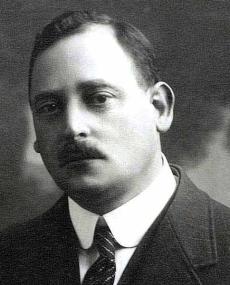
Ernest Oppenheimer was born on 22 May 1880 in Friedberg, Germany. He was the son of Edward Oppenheimer, a cigar merchant. Oppenheimer began his working life at 17, when he entered Dunkelsbuhler & Company, a diamond brokerage in London. His efforts impressed his employer and in 1902, at the age of 22, he was sent to South Africa to represent the company as a buyer in Kimberley.
On 19 June 1906 he married Mary Lina Pollock from London, with whom he had 2 sons. Two years after her death in 1934, Oppenheimer married Caroline Harvey, daughter of a knighted Briton.
Oppenheimer was active in civil life and in 1908 he was elected to the city council, becoming mayor in 1912. He helped to establish the Kimberley Regiment when the First World War broke out, and he organised the labourers needed to build a railway line between Upington and the Namibian border. In 1921, the British government conferred on him a knighthood, however the war fanned anti-German sentiment in the town, and assumptions around his surname led to the stoning of his house during 1916 riots.
In 1924, as member of the South African Party under General Jan Smuts, Oppenheimer represented Kimberley in Parliament. He kept aloof of parliamentary debates on racial issues, focussing his attention instead on financial and economic issues until his retirement from politics in 1938. Some historians regard Oppenheimer as somewhat progressive, pointing out that he was the first to provide adequate housing for Black mineworkers and their families on the copper mines in what was known as Northern Rhodesia, or Zambia today. To access a social history of diamond and gold mining in South Africa, taking a contrary approach to Oppenheimer ...read more
In 1910 Oppenheimer saw the economic promise of German South West Africa (Namibia) in its diamond mining potential. He wrested control of confiscated German mining interests. This eventually led to the strengthening of AAC’s interests in the Consolidated Diamond Mines of South-West Africa, financed largely by the AAC. The company expanded its gold mining influence by venturing into the Orange Free State and the East Rand.
Oppenheimer moved to Johannesburg, where his family held mining interests.
He became great friends with an American engineer called W. L. Honnold who had developed two mines on the East Rand and believed there was more gold in the area. Oppenheimer agreed with him and in September 1917 they launched the Anglo-American Corporation of South Africa (AAC) with financial assistance from J. P. Morgan ...read more
From 1888 British imperialist, Rhodes, had controlled the entire diamond market through two agencies. The first, De Beers Consolidated Mines Ltd, he formed in 1880. The second, a cartel called the London Diamond Syndicate, who were then the biggest diamond merchants, provided him with critical information about the diamond market. Such inside information allowed Rhodes (and later Oppenheimer) to create an artificially controlled supply of diamonds - to perfectly match supply with demand - thus manipulating the cost to the consumer. In return for their assistance, the diamond merchants were guaranteed a certain amount of diamonds from the many mines Rhodes controlled.
After the First World War ended, the diamond industry over produced beyond demand and led to a price plummet that resulted in the shutdown of the Kimberley mines. Oppenheimer was instrumental in creating a cartel that eventually controlled the diamond price. Following the model of his predecessor by using a single channel marketing structure, Oppenheimer formed the Central Selling Organization (CSO), effectively incorporating other major sellers and producers into the De Beers syndicate. He became a director of De Beers in 1926. When Dr Hans Merensky discovered diamonds in Namaqualand in 1927, the South African government consulted Oppenheimer who quickly became a leading figure in the new diamond field. In 1929 he was elected chairman of the board of De Beers. Oppenheimer’s strategy was tested through the Great Depression as the supply of mined diamonds was significantly higher than buyer demand. He was forced to close many of De Beers mines and obliged to meet purchase agreements with members of the CSO, as arranged. Oppenheimer’s efforts stabilised sales. In 1930 he formed the Diamond Corporation, which enabled the De Beers diamond conglomerate and other producers to have a direct interest in the sale of the minerals.
Apart from chairing the AAC and De Beers, Oppenheimer was deputy chair of the Rhokana Corporation and served on the commissions that led to the creation of the South African Reserve Bank. He served as a director of Barclay's Bank and the British South Africa Company. In the Second World War he helped establish diamond-cutting factories in South Africa to replace the ones in Europe. Under his leadership Anglo-American grew into a multi-million Rand business.
Oppenheimer had associations with several local and British universities. He helped establish an engineering department at the University of Stellenbosch. He also donated funds to the Oxford University for the establishment of a centre of colonial research and was awarded several honorary degrees.
In 1956 Sir Ernest Oppenheimer’s health failed and he died the following year. He left his entire fortune to his only surviving son Harry who followed in his father’s footsteps.